DSG Logistics Company
Operation Management
Our Propositions
Vehicle aManagement
A) We ensure all vehicles used for the delivery are properly checked before each travel to be sure truck is in good working condition and can sustain for traveling at far distance. As policy vehicle complies with the country's Land Transport Department (LTD) requirement; drivers must conduct and record daily Truck Pre-Start Safety Check on entry Form Sheet (DSG-QAF-001) and hand them in all documents to the Area Supervisor of certain destination.
B) All vehicles including GPS in both Thailand and Laos P.D.R., are covered by routine maintenance program or inspection/test; GPS Real Time Tracking System capabilities include:
LocationspeedRPMdistancemoving timeidle timetrip time
Fuel consumption
C) All maintenance programs are properly recorded and kept for inspection purposes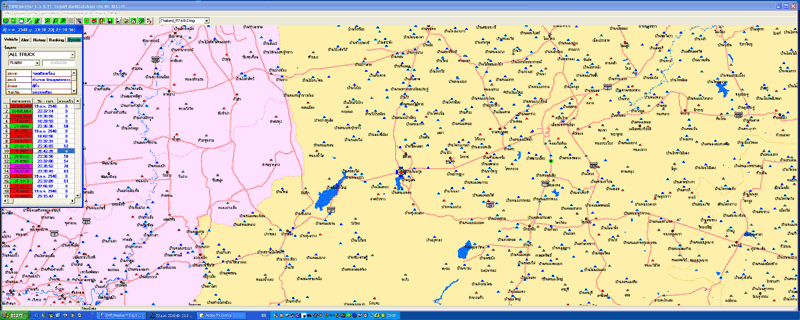
D) All vehicles meet the emission standards and licensing requirements imposed by relevant authorities;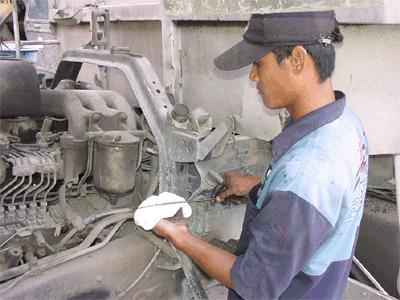
E) Tires, Brake and Suspension
(i) All Vehicle are fitted with tires with tread depth of:
Front axle:3.0 mm over the whole tread patterndrive axle: 1.5mm over the whole tread patternaxles: 1.5mm over the whole tread pattern
Retread tires will not used on steer axles.
(ii) Each vehicle has functioning brake with linings to meet the minimum wear tolerances.
F) Safety Equipment Accident / Incident
(i) We maintain lists of safety equipment that requires by each vehicle and these are properly checked prior to any trip to ensure all equipments are available and in good working condition. Thus, this equipment should be maintained, inspected and tested on a regular basis and records should be kept and intact for inspection purposes.
(ii) Minimum safety equipment in a truck's cabin are:
- First Aid Kit
- 2 Fire Extinguisher (foam type and dry powder)
- Warning triangle/ Safety cone
- Torch light
- Spare Bulbs and fuses
- Spil kits
Training must be implemented to all personnel so as to know the proper use of equipment for personal protection, emergency rescue and on the cyanide first-aid. Facilities are inspected and recorded on the inspection forms, log books or other means must includes the date of inspection, name of inspector and records any detected defect and be reported. The description and date of adjustment should be recorded. All trucks handling petrochemical products must meet its specifications.
Travel Management
In selecting routes, transporters should knows some options and alternative method in identifying the necessary approach to minimize delays and risks.
a) Route Scheduling and Rest Areas
i) For each traffic flow, we will:
Perform or conduct check- up on road restrictions prior to its travel.
Select route which has minimal traffic zone. In selecting routes, transporters shall assess the risks of alternative transport methods and identify options to minimize risks.
If necessary avoid route which passes an area which is residence areas or which considered accident- prone
ii) We conduct regular inspection to ensure drivers comply with the pre-assigned routes and stop-over areas.
iii) We conduct regular audit to prevent from risks of any forthcoming negative occurrences and keep updated with latest accident/incident cautionary measures.
iv) Truck speed limits are 60 km/hours on superhighway or 40 km/hours and less speed in the city and to any reduced speed zone are always observed by the drivers.
v) For trucks with Principal or Dangerous Goods onboard are always given an extra care and attention. If in an inevitable circumstances drivers are reminded to park their trucks at safe place and be visible to anyone.
b) Working/Driving Hours
i) Drivers are not allowed to drive for 4 hours successively they must take a rest and stopped for a minimum of 15 minutes.
ii) Drivers must have at least 8 hours rest and not worked for the last 12 hours prior to the next trip. Drivers' fatigue eliminate by “Driver Roaster Planning”
iii) Drivers must not drive more than 12 hours a day.
iv) There must 2 drivers on board if the travel exceeds 700km.
Emergency Response Management
a) The company has implement written accident/incident report procedures and let personnel trained so as they can respond in case of emergency or accident/incident happens. Personnel involved in cyanide management had been trained to handle cyanide in manner that it protects safety for the environment and for the workers.
b) We have made available lists of emergency contact numbers in each truck and update lists if there are changes for new contact numbers.
c) We make sure emergency contact personnel are always available 24 hours a day to receive any calls or notice of emergency.
d) Report any accident/ incident to DSG Logistics personnel within the stipulate time;
- Verbal notification – immediately
- Preliminary report – within 24 hrs of the accident
- Final report – within the next 7 days of the mishap
- If accident occurs, always make sure the report states clearly with the following:
- date and time of accident
- place / location
- fatality/ injury
- products damage
- property loss
e) We do provide appropriate emergency response team, including cyanide- personal protective equipment and vehicle to transfer cargos from affected vehicle and must clean the area of incident /accident before leaving.
f) We do an evaluation of our emergency preparedness by enactment on mock up of an emergency situation on each site twice a year. Mock emergency be conducted to learn in terms of drills to expose and to try its procedures.
Drivers Management
We have an appropriate recruitment policy on hiring drivers to make sure only qualified drivers are employed for the service. As a policy of the company, driver must examined through a written test for familiarity of truck driving principles, highway regulations and hazardous materials regulations (for cargo- driver on hazardous material) and actual driving test.) Drivers must have a minimum of 2 years experience in driving heavy vehicles.
b) Drivers must have a complete training in Defensive Driving and it must be renewed annually.
c) Drivers must have Laos P.D.R. and Thai government driver's license.
d) Drivers must undergo medical check-up prior of employment to ensure they fit for driving jobs, free from drugs and alcohol and it must be done once a year .
e) Drug and Alcohol precisely not allowed most specially during working hours.
f) With respect of any road transport operations, drivers are warned about the use of alcohol or abuse of illegal drugs or medicines are strictly prohibited.
Protective Equipment (PPE)
i)We make sure all personnel who wants to be on site will be have appropriate PPE.
ii) Minimum PPE requirements are:
- Safety helmet / hard hat
- Safety glasses/goggles
- Shirt
- Reflective vest
- Long pants
- Safety shoes/ steel toe shoes
- Gloves
- Respirator
Container for Chemical Transportation
-IBC 's Tank or drum of chemicals.
For transportation of IBC's tank, it should carries in a closed container with lock and a proper identifying seal.
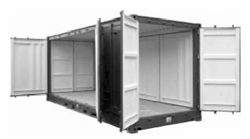
-ISO Tank
We transport ISO tank by 20' skeleton trailer for easy passage through the shape curve and stiff turning
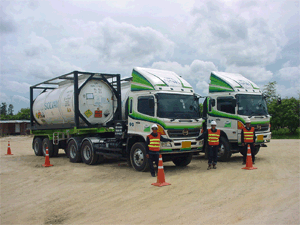
-Bulk Container
This will be used in huge amount of delivery of a certain trip.
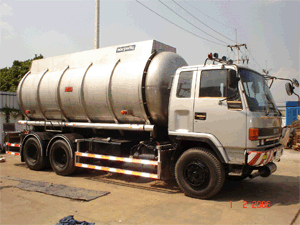
-Chemical substance in two (2) tons bag.
We carry flat bed trailer and have proper gadget to protect cargos from water.
